Global Business Environment and Strategic Analysis of SASOL Limited
VerifiedAdded on 2020/10/23
|8
|2174
|467
Report
AI Summary
This report provides a comprehensive analysis of SASOL Limited's global business environment. It begins with an introduction to globalization and its impact on businesses. The core of the report is structured around two projects. Project 1 is covered in a PPT. Project 2 delves into the application of McKinsey's 7S model to assess the organization's structure, strategy, and systems, as well as its soft elements like shared values, skills, style and staff. It then applies Hofstede's Dimensions of Culture to understand how cultural factors influence SASOL's operations. The report also evaluates the ethical and sustainable factors SASOL must consider, including compliance with laws and corporate social responsibility, and assesses how these factors affect decision-making in a global context. Furthermore, it examines the strategic expansion routes SASOL has taken, analyzing the advantages and disadvantages of each approach, before concluding with a summary of the findings and a list of references. The report highlights the complexities of operating in a global market and the importance of adapting to various economic, political, human, and ethical factors to succeed.
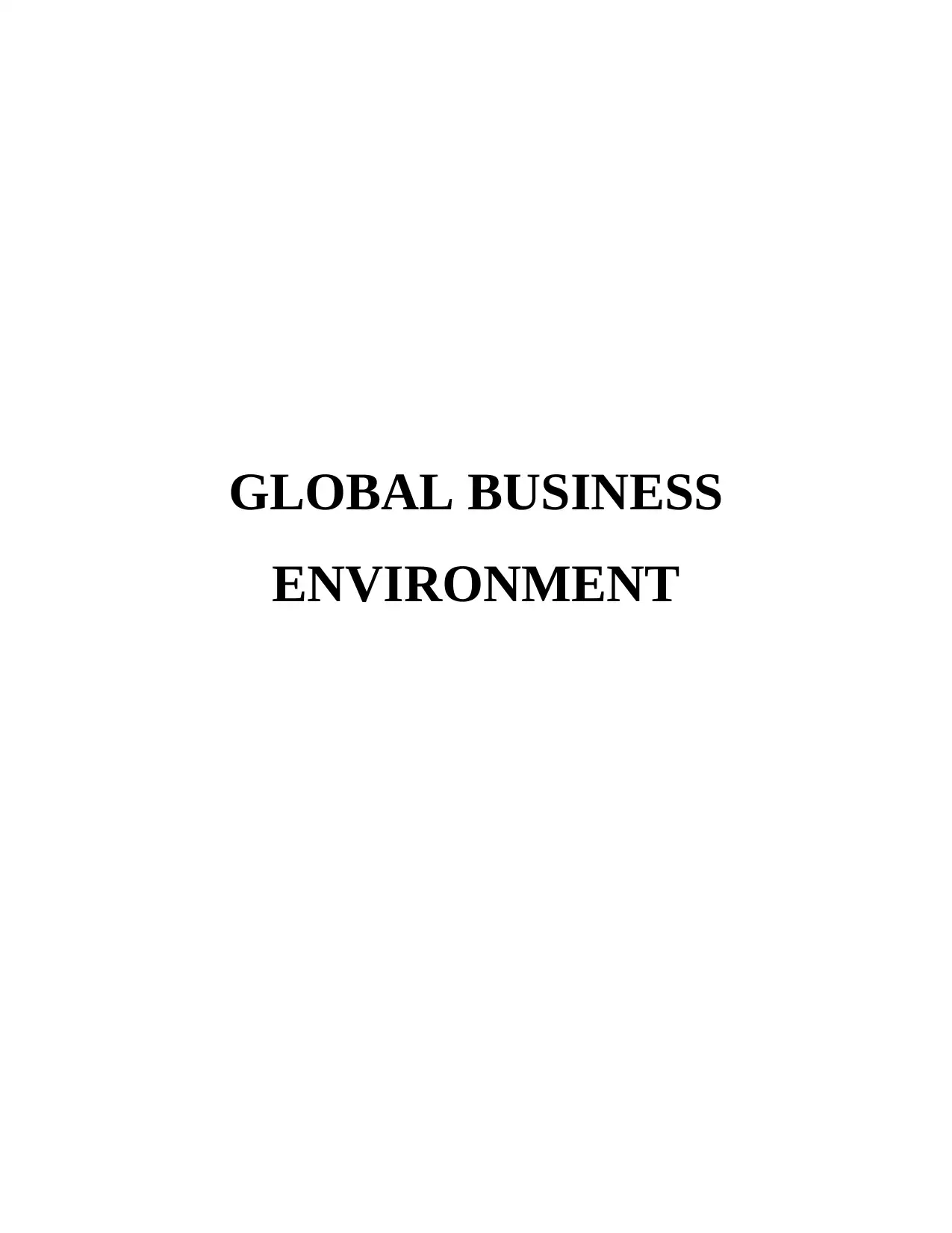
GLOBAL BUSINESS
ENVIRONMENT
ENVIRONMENT
Paraphrase This Document
Need a fresh take? Get an instant paraphrase of this document with our AI Paraphraser
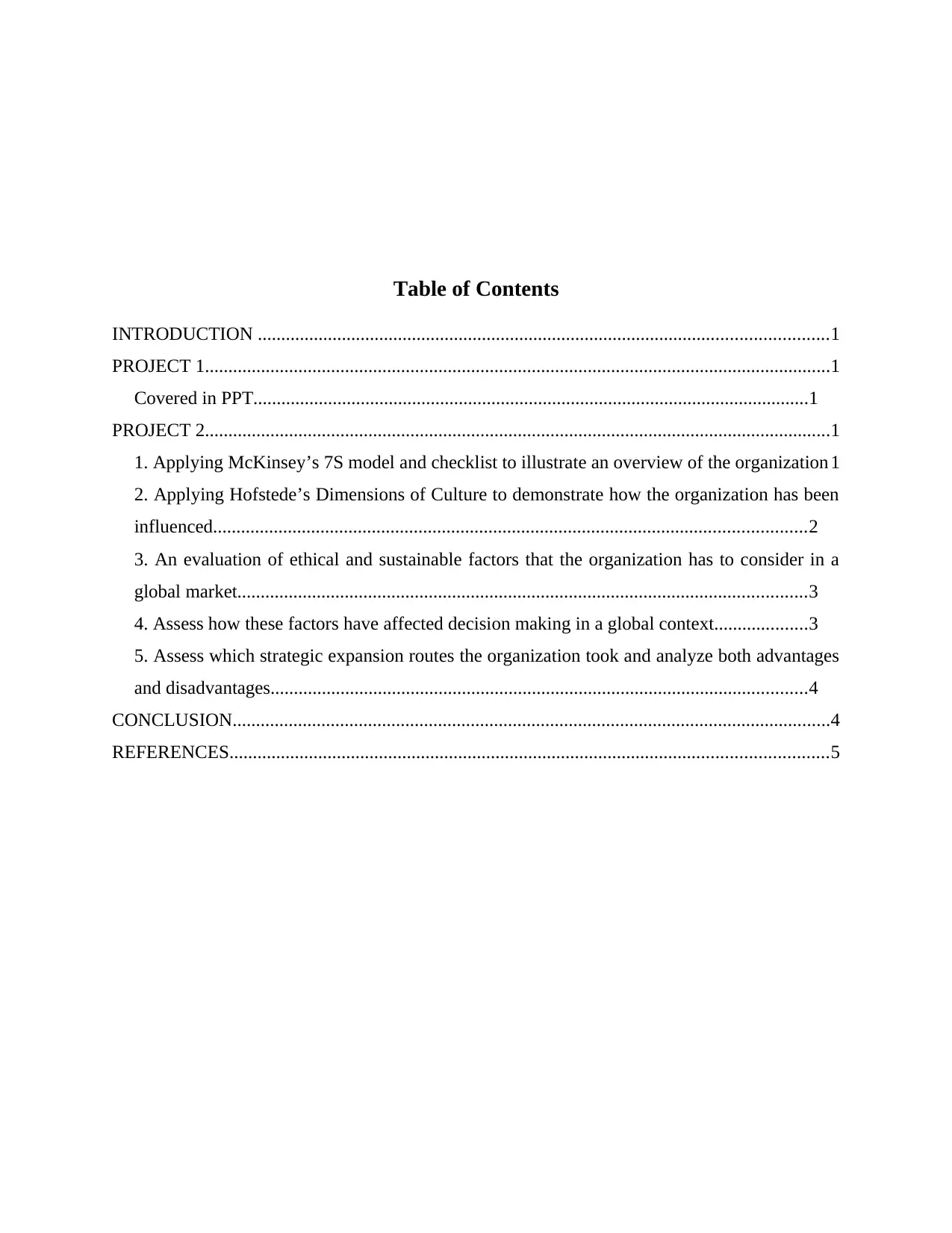
Table of Contents
INTRODUCTION ..........................................................................................................................1
PROJECT 1......................................................................................................................................1
Covered in PPT.......................................................................................................................1
PROJECT 2......................................................................................................................................1
1. Applying McKinsey’s 7S model and checklist to illustrate an overview of the organization 1
2. Applying Hofstede’s Dimensions of Culture to demonstrate how the organization has been
influenced...............................................................................................................................2
3. An evaluation of ethical and sustainable factors that the organization has to consider in a
global market..........................................................................................................................3
4. Assess how these factors have affected decision making in a global context....................3
5. Assess which strategic expansion routes the organization took and analyze both advantages
and disadvantages...................................................................................................................4
CONCLUSION................................................................................................................................4
REFERENCES................................................................................................................................5
INTRODUCTION ..........................................................................................................................1
PROJECT 1......................................................................................................................................1
Covered in PPT.......................................................................................................................1
PROJECT 2......................................................................................................................................1
1. Applying McKinsey’s 7S model and checklist to illustrate an overview of the organization 1
2. Applying Hofstede’s Dimensions of Culture to demonstrate how the organization has been
influenced...............................................................................................................................2
3. An evaluation of ethical and sustainable factors that the organization has to consider in a
global market..........................................................................................................................3
4. Assess how these factors have affected decision making in a global context....................3
5. Assess which strategic expansion routes the organization took and analyze both advantages
and disadvantages...................................................................................................................4
CONCLUSION................................................................................................................................4
REFERENCES................................................................................................................................5
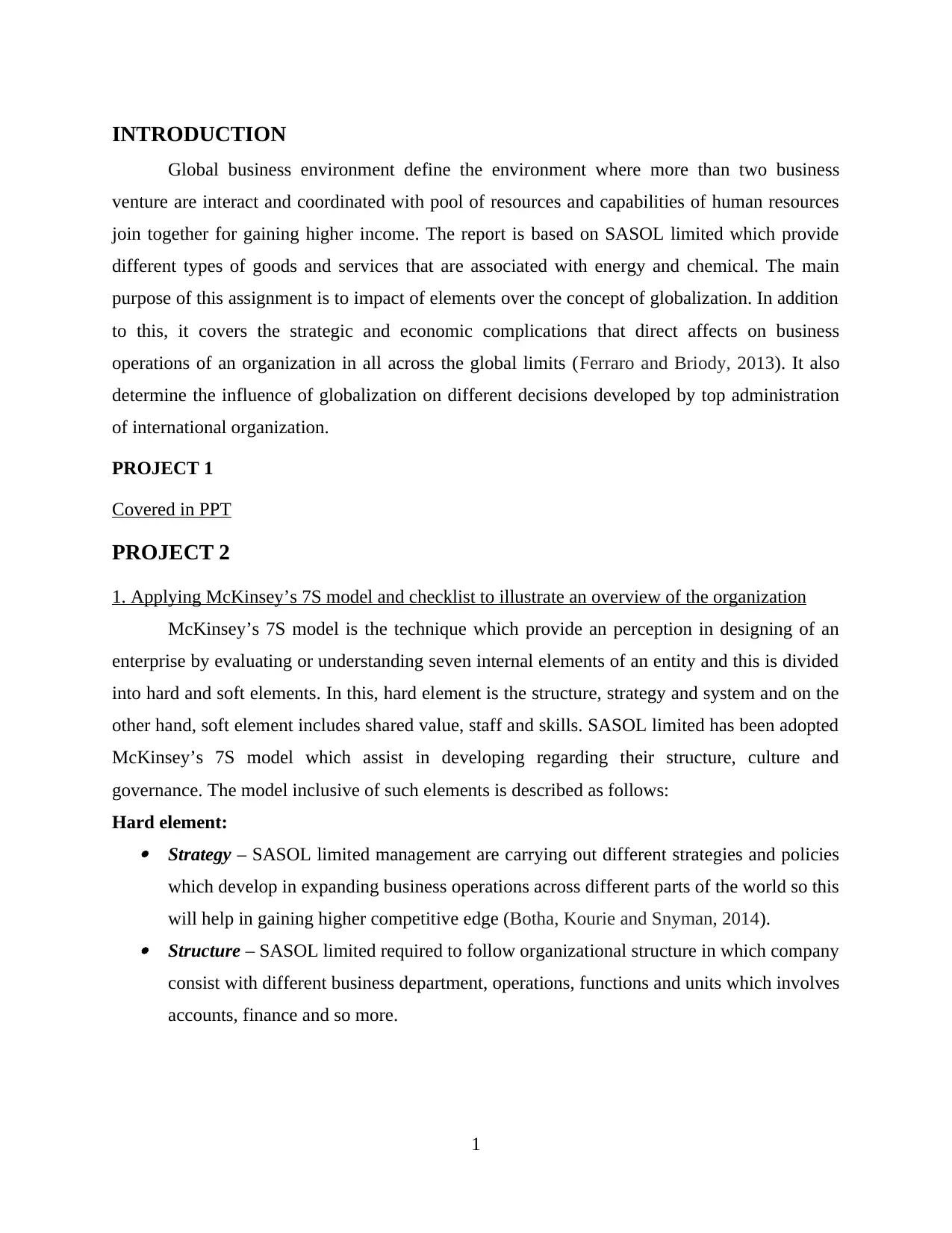
INTRODUCTION
Global business environment define the environment where more than two business
venture are interact and coordinated with pool of resources and capabilities of human resources
join together for gaining higher income. The report is based on SASOL limited which provide
different types of goods and services that are associated with energy and chemical. The main
purpose of this assignment is to impact of elements over the concept of globalization. In addition
to this, it covers the strategic and economic complications that direct affects on business
operations of an organization in all across the global limits (Ferraro and Briody, 2013). It also
determine the influence of globalization on different decisions developed by top administration
of international organization.
PROJECT 1
Covered in PPT
PROJECT 2
1. Applying McKinsey’s 7S model and checklist to illustrate an overview of the organization
McKinsey’s 7S model is the technique which provide an perception in designing of an
enterprise by evaluating or understanding seven internal elements of an entity and this is divided
into hard and soft elements. In this, hard element is the structure, strategy and system and on the
other hand, soft element includes shared value, staff and skills. SASOL limited has been adopted
McKinsey’s 7S model which assist in developing regarding their structure, culture and
governance. The model inclusive of such elements is described as follows:
Hard element: Strategy – SASOL limited management are carrying out different strategies and policies
which develop in expanding business operations across different parts of the world so this
will help in gaining higher competitive edge (Botha, Kourie and Snyman, 2014). Structure – SASOL limited required to follow organizational structure in which company
consist with different business department, operations, functions and units which involves
accounts, finance and so more.
1
Global business environment define the environment where more than two business
venture are interact and coordinated with pool of resources and capabilities of human resources
join together for gaining higher income. The report is based on SASOL limited which provide
different types of goods and services that are associated with energy and chemical. The main
purpose of this assignment is to impact of elements over the concept of globalization. In addition
to this, it covers the strategic and economic complications that direct affects on business
operations of an organization in all across the global limits (Ferraro and Briody, 2013). It also
determine the influence of globalization on different decisions developed by top administration
of international organization.
PROJECT 1
Covered in PPT
PROJECT 2
1. Applying McKinsey’s 7S model and checklist to illustrate an overview of the organization
McKinsey’s 7S model is the technique which provide an perception in designing of an
enterprise by evaluating or understanding seven internal elements of an entity and this is divided
into hard and soft elements. In this, hard element is the structure, strategy and system and on the
other hand, soft element includes shared value, staff and skills. SASOL limited has been adopted
McKinsey’s 7S model which assist in developing regarding their structure, culture and
governance. The model inclusive of such elements is described as follows:
Hard element: Strategy – SASOL limited management are carrying out different strategies and policies
which develop in expanding business operations across different parts of the world so this
will help in gaining higher competitive edge (Botha, Kourie and Snyman, 2014). Structure – SASOL limited required to follow organizational structure in which company
consist with different business department, operations, functions and units which involves
accounts, finance and so more.
1
⊘ This is a preview!⊘
Do you want full access?
Subscribe today to unlock all pages.

Trusted by 1+ million students worldwide
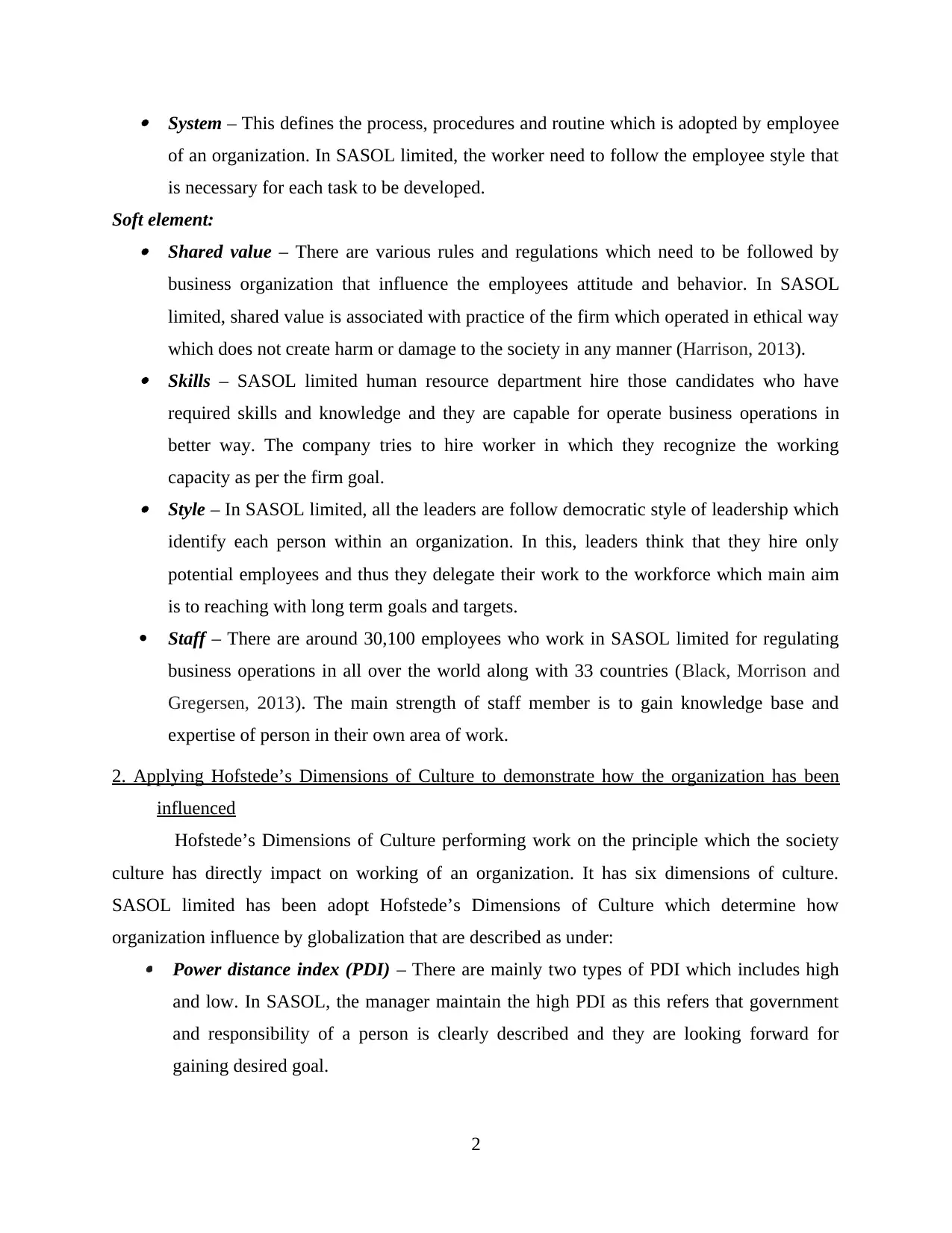
System – This defines the process, procedures and routine which is adopted by employee
of an organization. In SASOL limited, the worker need to follow the employee style that
is necessary for each task to be developed.
Soft element: Shared value – There are various rules and regulations which need to be followed by
business organization that influence the employees attitude and behavior. In SASOL
limited, shared value is associated with practice of the firm which operated in ethical way
which does not create harm or damage to the society in any manner (Harrison, 2013). Skills – SASOL limited human resource department hire those candidates who have
required skills and knowledge and they are capable for operate business operations in
better way. The company tries to hire worker in which they recognize the working
capacity as per the firm goal. Style – In SASOL limited, all the leaders are follow democratic style of leadership which
identify each person within an organization. In this, leaders think that they hire only
potential employees and thus they delegate their work to the workforce which main aim
is to reaching with long term goals and targets.
Staff – There are around 30,100 employees who work in SASOL limited for regulating
business operations in all over the world along with 33 countries (Black, Morrison and
Gregersen, 2013). The main strength of staff member is to gain knowledge base and
expertise of person in their own area of work.
2. Applying Hofstede’s Dimensions of Culture to demonstrate how the organization has been
influenced
Hofstede’s Dimensions of Culture performing work on the principle which the society
culture has directly impact on working of an organization. It has six dimensions of culture.
SASOL limited has been adopt Hofstede’s Dimensions of Culture which determine how
organization influence by globalization that are described as under: Power distance index (PDI) – There are mainly two types of PDI which includes high
and low. In SASOL, the manager maintain the high PDI as this refers that government
and responsibility of a person is clearly described and they are looking forward for
gaining desired goal.
2
of an organization. In SASOL limited, the worker need to follow the employee style that
is necessary for each task to be developed.
Soft element: Shared value – There are various rules and regulations which need to be followed by
business organization that influence the employees attitude and behavior. In SASOL
limited, shared value is associated with practice of the firm which operated in ethical way
which does not create harm or damage to the society in any manner (Harrison, 2013). Skills – SASOL limited human resource department hire those candidates who have
required skills and knowledge and they are capable for operate business operations in
better way. The company tries to hire worker in which they recognize the working
capacity as per the firm goal. Style – In SASOL limited, all the leaders are follow democratic style of leadership which
identify each person within an organization. In this, leaders think that they hire only
potential employees and thus they delegate their work to the workforce which main aim
is to reaching with long term goals and targets.
Staff – There are around 30,100 employees who work in SASOL limited for regulating
business operations in all over the world along with 33 countries (Black, Morrison and
Gregersen, 2013). The main strength of staff member is to gain knowledge base and
expertise of person in their own area of work.
2. Applying Hofstede’s Dimensions of Culture to demonstrate how the organization has been
influenced
Hofstede’s Dimensions of Culture performing work on the principle which the society
culture has directly impact on working of an organization. It has six dimensions of culture.
SASOL limited has been adopt Hofstede’s Dimensions of Culture which determine how
organization influence by globalization that are described as under: Power distance index (PDI) – There are mainly two types of PDI which includes high
and low. In SASOL, the manager maintain the high PDI as this refers that government
and responsibility of a person is clearly described and they are looking forward for
gaining desired goal.
2
Paraphrase This Document
Need a fresh take? Get an instant paraphrase of this document with our AI Paraphraser
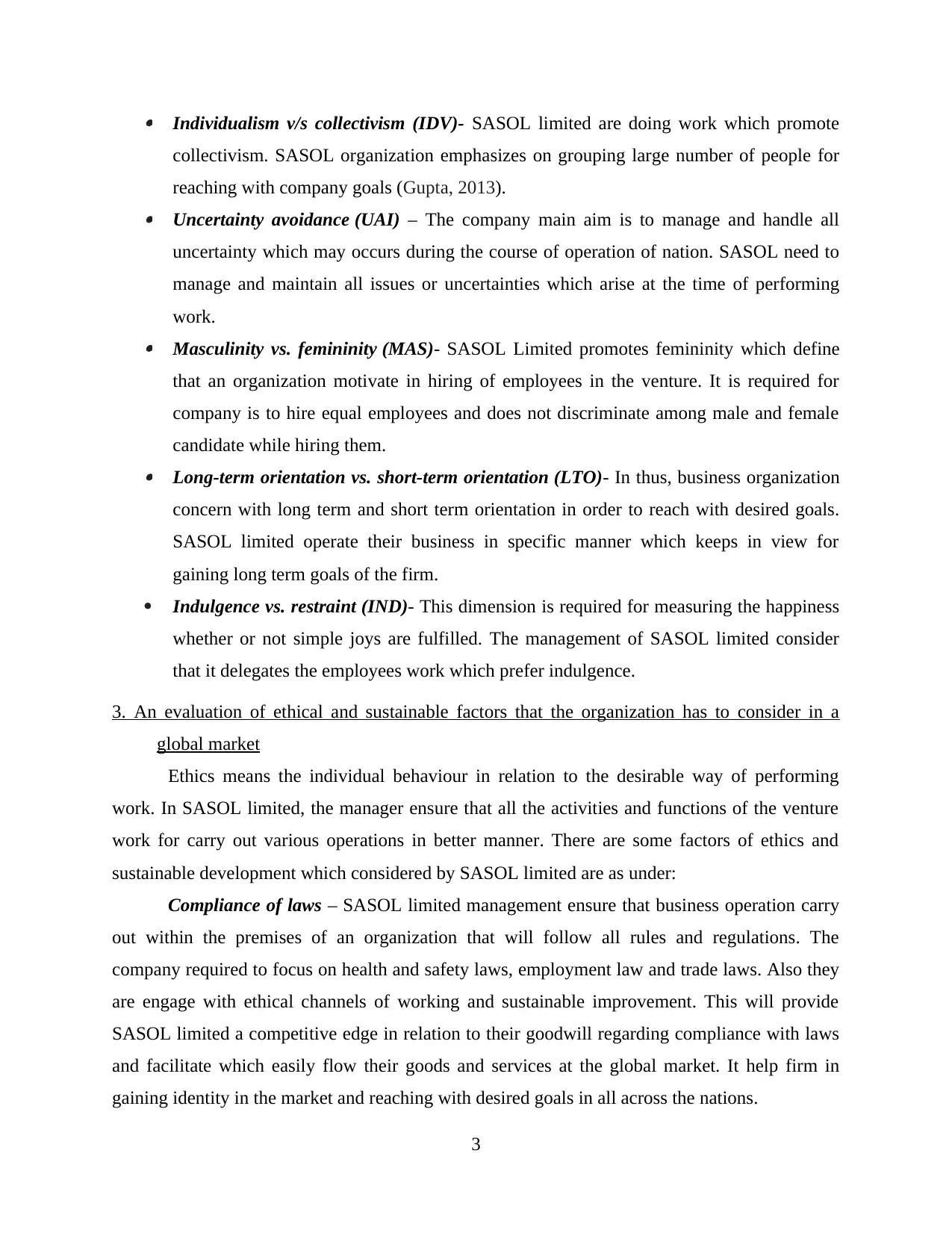
Individualism v/s collectivism (IDV)- SASOL limited are doing work which promote
collectivism. SASOL organization emphasizes on grouping large number of people for
reaching with company goals (Gupta, 2013). Uncertainty avoidance (UAI) – The company main aim is to manage and handle all
uncertainty which may occurs during the course of operation of nation. SASOL need to
manage and maintain all issues or uncertainties which arise at the time of performing
work. Masculinity vs. femininity (MAS)- SASOL Limited promotes femininity which define
that an organization motivate in hiring of employees in the venture. It is required for
company is to hire equal employees and does not discriminate among male and female
candidate while hiring them. Long-term orientation vs. short-term orientation (LTO)- In thus, business organization
concern with long term and short term orientation in order to reach with desired goals.
SASOL limited operate their business in specific manner which keeps in view for
gaining long term goals of the firm.
Indulgence vs. restraint (IND)- This dimension is required for measuring the happiness
whether or not simple joys are fulfilled. The management of SASOL limited consider
that it delegates the employees work which prefer indulgence.
3. An evaluation of ethical and sustainable factors that the organization has to consider in a
global market
Ethics means the individual behaviour in relation to the desirable way of performing
work. In SASOL limited, the manager ensure that all the activities and functions of the venture
work for carry out various operations in better manner. There are some factors of ethics and
sustainable development which considered by SASOL limited are as under:
Compliance of laws – SASOL limited management ensure that business operation carry
out within the premises of an organization that will follow all rules and regulations. The
company required to focus on health and safety laws, employment law and trade laws. Also they
are engage with ethical channels of working and sustainable improvement. This will provide
SASOL limited a competitive edge in relation to their goodwill regarding compliance with laws
and facilitate which easily flow their goods and services at the global market. It help firm in
gaining identity in the market and reaching with desired goals in all across the nations.
3
collectivism. SASOL organization emphasizes on grouping large number of people for
reaching with company goals (Gupta, 2013). Uncertainty avoidance (UAI) – The company main aim is to manage and handle all
uncertainty which may occurs during the course of operation of nation. SASOL need to
manage and maintain all issues or uncertainties which arise at the time of performing
work. Masculinity vs. femininity (MAS)- SASOL Limited promotes femininity which define
that an organization motivate in hiring of employees in the venture. It is required for
company is to hire equal employees and does not discriminate among male and female
candidate while hiring them. Long-term orientation vs. short-term orientation (LTO)- In thus, business organization
concern with long term and short term orientation in order to reach with desired goals.
SASOL limited operate their business in specific manner which keeps in view for
gaining long term goals of the firm.
Indulgence vs. restraint (IND)- This dimension is required for measuring the happiness
whether or not simple joys are fulfilled. The management of SASOL limited consider
that it delegates the employees work which prefer indulgence.
3. An evaluation of ethical and sustainable factors that the organization has to consider in a
global market
Ethics means the individual behaviour in relation to the desirable way of performing
work. In SASOL limited, the manager ensure that all the activities and functions of the venture
work for carry out various operations in better manner. There are some factors of ethics and
sustainable development which considered by SASOL limited are as under:
Compliance of laws – SASOL limited management ensure that business operation carry
out within the premises of an organization that will follow all rules and regulations. The
company required to focus on health and safety laws, employment law and trade laws. Also they
are engage with ethical channels of working and sustainable improvement. This will provide
SASOL limited a competitive edge in relation to their goodwill regarding compliance with laws
and facilitate which easily flow their goods and services at the global market. It help firm in
gaining identity in the market and reaching with desired goals in all across the nations.
3
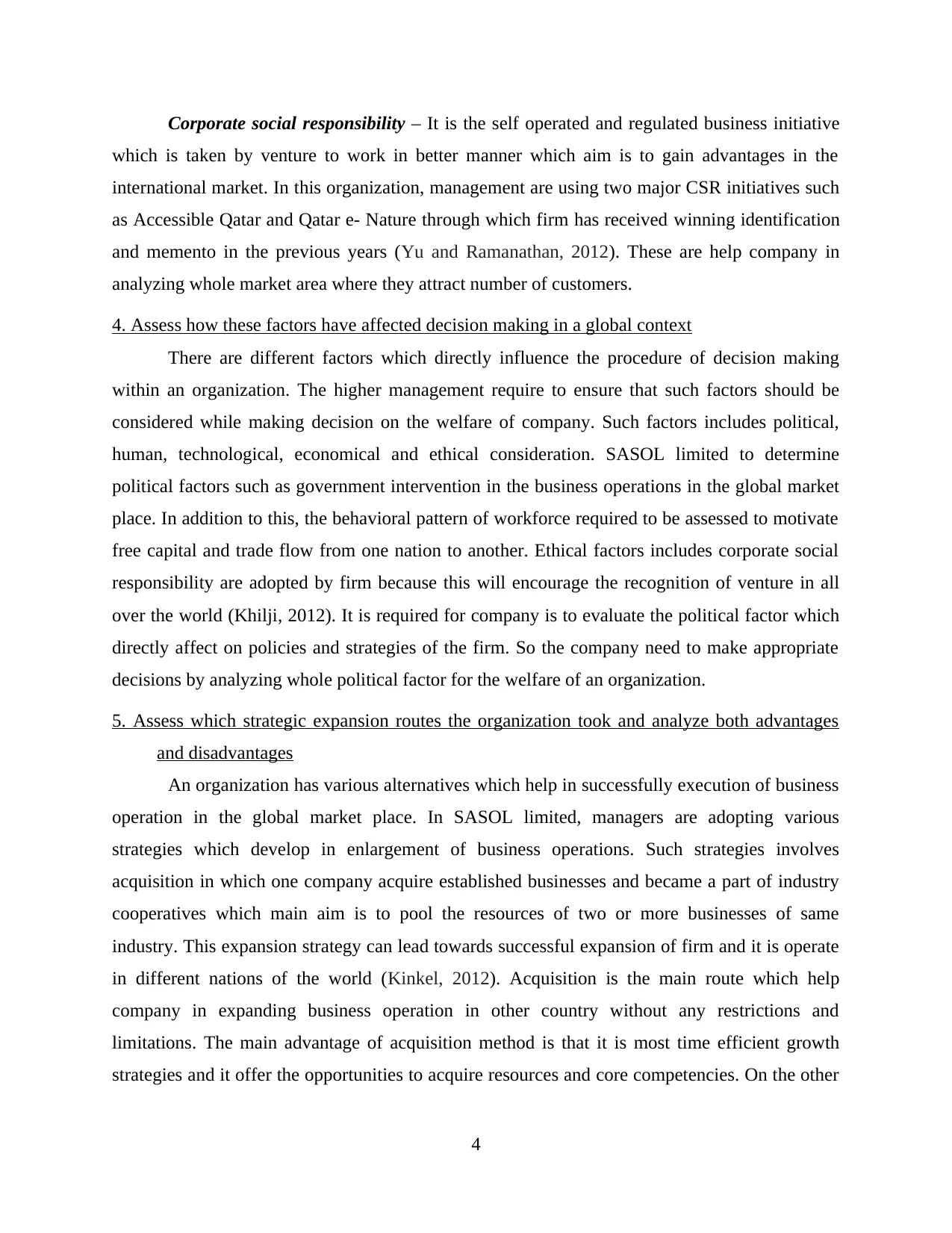
Corporate social responsibility – It is the self operated and regulated business initiative
which is taken by venture to work in better manner which aim is to gain advantages in the
international market. In this organization, management are using two major CSR initiatives such
as Accessible Qatar and Qatar e- Nature through which firm has received winning identification
and memento in the previous years (Yu and Ramanathan, 2012). These are help company in
analyzing whole market area where they attract number of customers.
4. Assess how these factors have affected decision making in a global context
There are different factors which directly influence the procedure of decision making
within an organization. The higher management require to ensure that such factors should be
considered while making decision on the welfare of company. Such factors includes political,
human, technological, economical and ethical consideration. SASOL limited to determine
political factors such as government intervention in the business operations in the global market
place. In addition to this, the behavioral pattern of workforce required to be assessed to motivate
free capital and trade flow from one nation to another. Ethical factors includes corporate social
responsibility are adopted by firm because this will encourage the recognition of venture in all
over the world (Khilji, 2012). It is required for company is to evaluate the political factor which
directly affect on policies and strategies of the firm. So the company need to make appropriate
decisions by analyzing whole political factor for the welfare of an organization.
5. Assess which strategic expansion routes the organization took and analyze both advantages
and disadvantages
An organization has various alternatives which help in successfully execution of business
operation in the global market place. In SASOL limited, managers are adopting various
strategies which develop in enlargement of business operations. Such strategies involves
acquisition in which one company acquire established businesses and became a part of industry
cooperatives which main aim is to pool the resources of two or more businesses of same
industry. This expansion strategy can lead towards successful expansion of firm and it is operate
in different nations of the world (Kinkel, 2012). Acquisition is the main route which help
company in expanding business operation in other country without any restrictions and
limitations. The main advantage of acquisition method is that it is most time efficient growth
strategies and it offer the opportunities to acquire resources and core competencies. On the other
4
which is taken by venture to work in better manner which aim is to gain advantages in the
international market. In this organization, management are using two major CSR initiatives such
as Accessible Qatar and Qatar e- Nature through which firm has received winning identification
and memento in the previous years (Yu and Ramanathan, 2012). These are help company in
analyzing whole market area where they attract number of customers.
4. Assess how these factors have affected decision making in a global context
There are different factors which directly influence the procedure of decision making
within an organization. The higher management require to ensure that such factors should be
considered while making decision on the welfare of company. Such factors includes political,
human, technological, economical and ethical consideration. SASOL limited to determine
political factors such as government intervention in the business operations in the global market
place. In addition to this, the behavioral pattern of workforce required to be assessed to motivate
free capital and trade flow from one nation to another. Ethical factors includes corporate social
responsibility are adopted by firm because this will encourage the recognition of venture in all
over the world (Khilji, 2012). It is required for company is to evaluate the political factor which
directly affect on policies and strategies of the firm. So the company need to make appropriate
decisions by analyzing whole political factor for the welfare of an organization.
5. Assess which strategic expansion routes the organization took and analyze both advantages
and disadvantages
An organization has various alternatives which help in successfully execution of business
operation in the global market place. In SASOL limited, managers are adopting various
strategies which develop in enlargement of business operations. Such strategies involves
acquisition in which one company acquire established businesses and became a part of industry
cooperatives which main aim is to pool the resources of two or more businesses of same
industry. This expansion strategy can lead towards successful expansion of firm and it is operate
in different nations of the world (Kinkel, 2012). Acquisition is the main route which help
company in expanding business operation in other country without any restrictions and
limitations. The main advantage of acquisition method is that it is most time efficient growth
strategies and it offer the opportunities to acquire resources and core competencies. On the other
4
⊘ This is a preview!⊘
Do you want full access?
Subscribe today to unlock all pages.

Trusted by 1+ million students worldwide
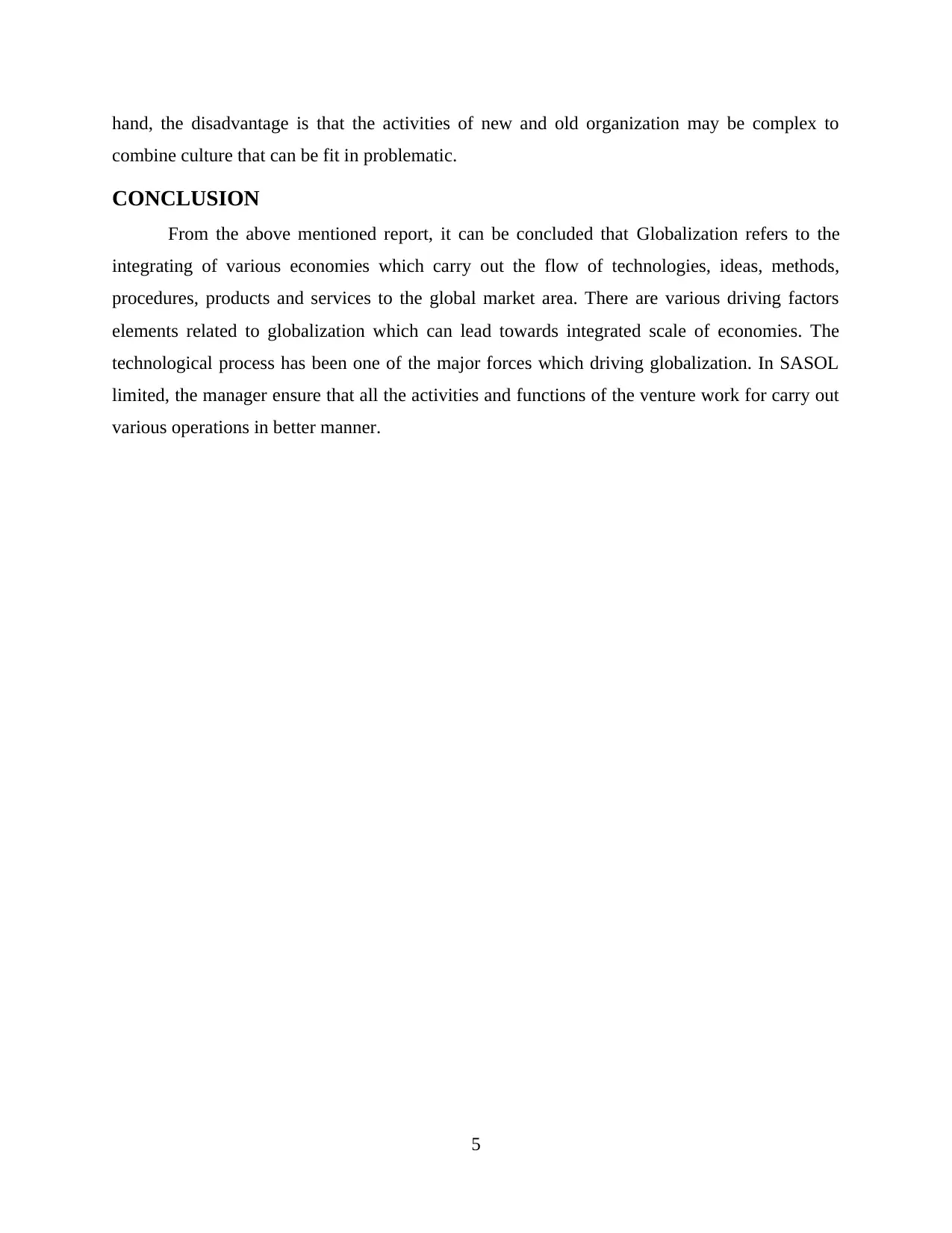
hand, the disadvantage is that the activities of new and old organization may be complex to
combine culture that can be fit in problematic.
CONCLUSION
From the above mentioned report, it can be concluded that Globalization refers to the
integrating of various economies which carry out the flow of technologies, ideas, methods,
procedures, products and services to the global market area. There are various driving factors
elements related to globalization which can lead towards integrated scale of economies. The
technological process has been one of the major forces which driving globalization. In SASOL
limited, the manager ensure that all the activities and functions of the venture work for carry out
various operations in better manner.
5
combine culture that can be fit in problematic.
CONCLUSION
From the above mentioned report, it can be concluded that Globalization refers to the
integrating of various economies which carry out the flow of technologies, ideas, methods,
procedures, products and services to the global market area. There are various driving factors
elements related to globalization which can lead towards integrated scale of economies. The
technological process has been one of the major forces which driving globalization. In SASOL
limited, the manager ensure that all the activities and functions of the venture work for carry out
various operations in better manner.
5
Paraphrase This Document
Need a fresh take? Get an instant paraphrase of this document with our AI Paraphraser
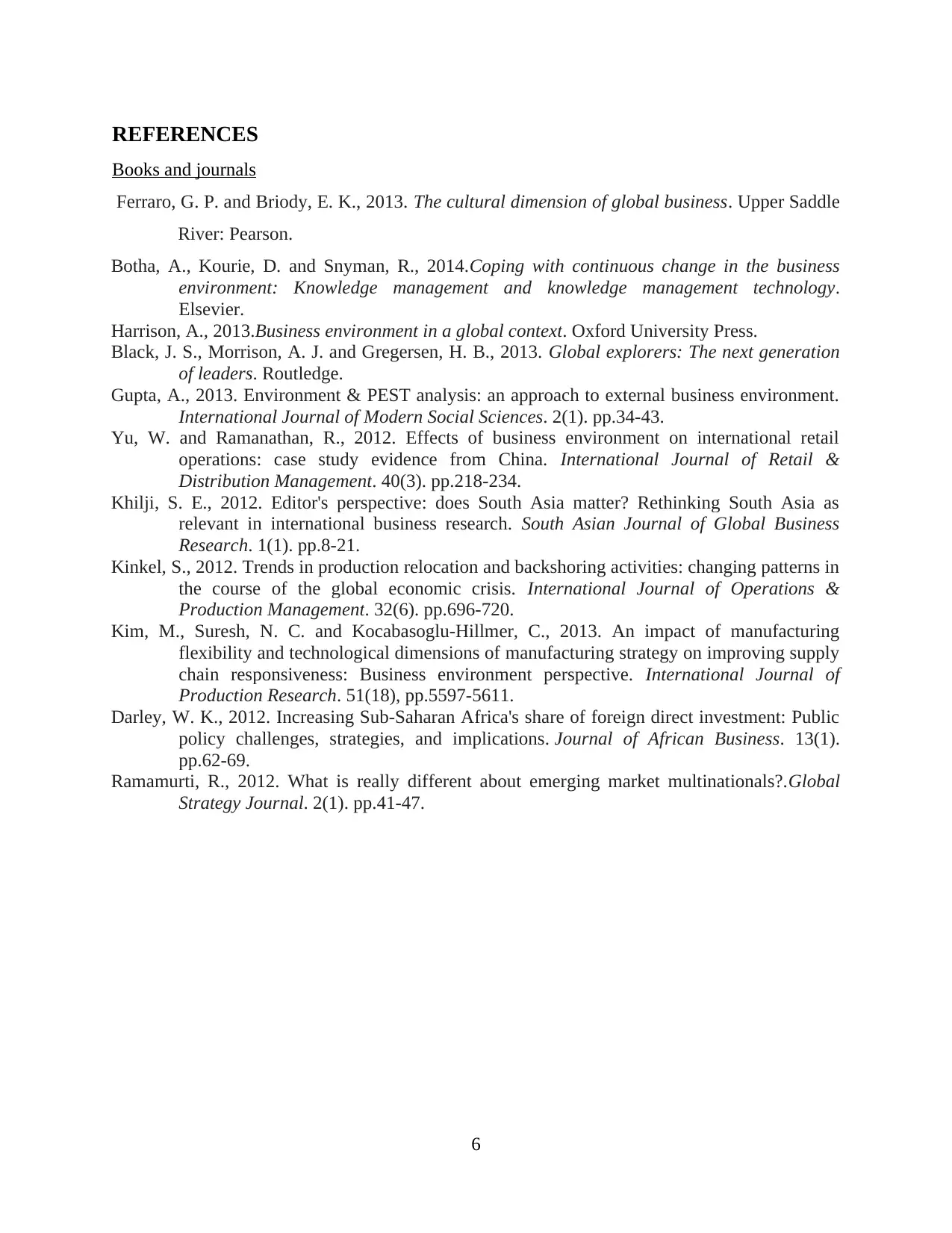
REFERENCES
Books and journals
Ferraro, G. P. and Briody, E. K., 2013. The cultural dimension of global business. Upper Saddle
River: Pearson.
Botha, A., Kourie, D. and Snyman, R., 2014.Coping with continuous change in the business
environment: Knowledge management and knowledge management technology.
Elsevier.
Harrison, A., 2013.Business environment in a global context. Oxford University Press.
Black, J. S., Morrison, A. J. and Gregersen, H. B., 2013. Global explorers: The next generation
of leaders. Routledge.
Gupta, A., 2013. Environment & PEST analysis: an approach to external business environment.
International Journal of Modern Social Sciences. 2(1). pp.34-43.
Yu, W. and Ramanathan, R., 2012. Effects of business environment on international retail
operations: case study evidence from China. International Journal of Retail &
Distribution Management. 40(3). pp.218-234.
Khilji, S. E., 2012. Editor's perspective: does South Asia matter? Rethinking South Asia as
relevant in international business research. South Asian Journal of Global Business
Research. 1(1). pp.8-21.
Kinkel, S., 2012. Trends in production relocation and backshoring activities: changing patterns in
the course of the global economic crisis. International Journal of Operations &
Production Management. 32(6). pp.696-720.
Kim, M., Suresh, N. C. and Kocabasoglu-Hillmer, C., 2013. An impact of manufacturing
flexibility and technological dimensions of manufacturing strategy on improving supply
chain responsiveness: Business environment perspective. International Journal of
Production Research. 51(18), pp.5597-5611.
Darley, W. K., 2012. Increasing Sub-Saharan Africa's share of foreign direct investment: Public
policy challenges, strategies, and implications. Journal of African Business. 13(1).
pp.62-69.
Ramamurti, R., 2012. What is really different about emerging market multinationals?.Global
Strategy Journal. 2(1). pp.41-47.
6
Books and journals
Ferraro, G. P. and Briody, E. K., 2013. The cultural dimension of global business. Upper Saddle
River: Pearson.
Botha, A., Kourie, D. and Snyman, R., 2014.Coping with continuous change in the business
environment: Knowledge management and knowledge management technology.
Elsevier.
Harrison, A., 2013.Business environment in a global context. Oxford University Press.
Black, J. S., Morrison, A. J. and Gregersen, H. B., 2013. Global explorers: The next generation
of leaders. Routledge.
Gupta, A., 2013. Environment & PEST analysis: an approach to external business environment.
International Journal of Modern Social Sciences. 2(1). pp.34-43.
Yu, W. and Ramanathan, R., 2012. Effects of business environment on international retail
operations: case study evidence from China. International Journal of Retail &
Distribution Management. 40(3). pp.218-234.
Khilji, S. E., 2012. Editor's perspective: does South Asia matter? Rethinking South Asia as
relevant in international business research. South Asian Journal of Global Business
Research. 1(1). pp.8-21.
Kinkel, S., 2012. Trends in production relocation and backshoring activities: changing patterns in
the course of the global economic crisis. International Journal of Operations &
Production Management. 32(6). pp.696-720.
Kim, M., Suresh, N. C. and Kocabasoglu-Hillmer, C., 2013. An impact of manufacturing
flexibility and technological dimensions of manufacturing strategy on improving supply
chain responsiveness: Business environment perspective. International Journal of
Production Research. 51(18), pp.5597-5611.
Darley, W. K., 2012. Increasing Sub-Saharan Africa's share of foreign direct investment: Public
policy challenges, strategies, and implications. Journal of African Business. 13(1).
pp.62-69.
Ramamurti, R., 2012. What is really different about emerging market multinationals?.Global
Strategy Journal. 2(1). pp.41-47.
6
1 out of 8
Related Documents
Your All-in-One AI-Powered Toolkit for Academic Success.
+13062052269
info@desklib.com
Available 24*7 on WhatsApp / Email
![[object Object]](/_next/static/media/star-bottom.7253800d.svg)
Unlock your academic potential
Copyright © 2020–2025 A2Z Services. All Rights Reserved. Developed and managed by ZUCOL.




